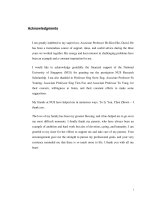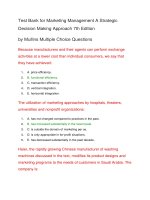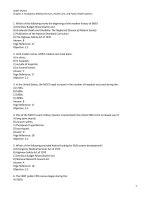Business statistics a decision making approach 6th edition ch08ppln
Bạn đang xem bản rút gọn của tài liệu. Xem và tải ngay bản đầy đủ của tài liệu tại đây (363.19 KB, 56 trang )
Business Statistics:
A Decision-Making Approach
6th Edition
Chapter 8
Introduction to
Hypothesis Testing
Business Statistics: A Decision-Making Approach, 6e © 2010 PrenticeHall, Inc.
Chap 8-1
Chapter Goals
After completing this chapter, you should be
able to:
Formulate null and alternative hypotheses for
applications involving a single population mean or
proportion
Formulate a decision rule for testing a hypothesis
Know how to use the test statistic, critical value, and
p-value approaches to test the null hypothesis
Know what Type I and Type II errors are
Compute the probability of a Type II error
Business Statistics: A Decision-Making Approach, 6e © 2010 PrenticeHall, Inc.
Chap 8-2
What is a Hypothesis?
A hypothesis is a claim
(assumption) about a
population parameter:
population mean
Example: The mean monthly cell phone bill
of this city is = $42
population proportion
Example: The proportion of adults in this
city with cell phones is p = .68
Business Statistics: A Decision-Making Approach, 6e © 2010 PrenticeHall, Inc.
Chap 8-3
The Null Hypothesis, H0
States the assumption (numerical) to be
tested
Example: The average number of TV sets in
U.S. Homes is at least three ( H0 : μ 3 )
Is always about a population parameter,
not about a sample statistic
H0 : μ 3
Business Statistics: A Decision-Making Approach, 6e © 2010 PrenticeHall, Inc.
H0 : x 3
Chap 8-4
The Null Hypothesis, H0
(continued)
Begin with the assumption that the null
hypothesis is true
Similar to the notion of innocent until
proven guilty
Refers to the status quo
Always contains “=” , “≤” or “” sign
May or may not be rejected
Business Statistics: A Decision-Making Approach, 6e © 2010 PrenticeHall, Inc.
Chap 8-5
The Alternative Hypothesis,
HA
Is the opposite of the null hypothesis
e.g.: The average number of TV sets in U.S.
homes is less than 3 ( HA: < 3 )
Challenges the status quo
Never contains the “=” , “≤” or “” sign
May or may not be accepted
Is generally the hypothesis that is believed
(or needs to be supported) by the
researcher
Business Statistics: A Decision-Making Approach, 6e © 2010 PrenticeHall, Inc.
Chap 8-6
Hypothesis Testing Process
Claim: the
population
mean age is 50.
(Null Hypothesis:
H0: = 50 )
Population
Is x20 likely if = 50?
Suppose
the sample
REJECT
mean age
Null Hypothesis
is 20: x = 20
Business Statistics: A Decision-Making Approach, 6e © 2010 Prentice-
Now select a
random sample
If not likely,
Hall, Inc.
Sample
Reason for Rejecting H0
Sampling Distribution of x
20
x
= 50
If H0 is true
If it is unlikely that
we would get a
... if in fact this were
sample mean of
the population mean…
this
value
...
Business Statistics: A Decision-Making Approach, 6e © 2010 PrenticeHall, Inc.
... then we
reject the null
hypothesis that
= 50.
Chap 8-8
Level of Significance,
Defines unlikely values of sample statistic if
null hypothesis is true
Defines rejection region of the sampling
distribution
Is designated by , (level of significance)
Typical values are .01, .05, or .10
Is selected by the researcher at the beginning
Provides the critical value(s) of the test
Business Statistics: A Decision-Making Approach, 6e © 2010 PrenticeHall, Inc.
Chap 8-9
Level of Significance
and the Rejection Region
Level of significance =
H0: μ ≥ 3
HA: μ < 3
H0: μ ≤ 3
HA: μ > 3
H0: μ = 3
HA: μ ≠ 3
Represents
critical value
Rejection
region is
shaded
0
Lower tail test
0
Upper tail test
/2
Two tailed test
Business Statistics: A Decision-Making Approach, 6e © 2010 PrenticeHall, Inc.
/2
0
Chap 8-10
Errors in Making Decisions
Type I Error
Reject a true null hypothesis
Considered a serious type of error
The probability of Type I Error is
Called level of significance of the test
Set by researcher in advance
Business Statistics: A Decision-Making Approach, 6e © 2010 PrenticeHall, Inc.
Chap 8-11
Errors in Making Decisions
(continued)
Type II Error
Fail to reject a false null hypothesis
The probability of Type II Error is β
Business Statistics: A Decision-Making Approach, 6e © 2010 PrenticeHall, Inc.
Chap 8-12
Outcomes and Probabilities
Possible Hypothesis Test Outcomes
State of Nature
Key:
Outcome
(Probability)
Decision
H0 True
Do Not
Reject
H0
No error
(1 - )
Type II Error
(β)
Reject
H0
Type I Error
()
No Error
(1-β)
Business Statistics: A Decision-Making Approach, 6e © 2010 PrenticeHall, Inc.
H0 False
Chap 8-13
Type I & II Error Relationship
Type I and Type II errors can not happen at
the same time
Type I error can only occur if H0 is true
Type II error can only occur if H0 is false
If Type I error probability ( )
, then
Type II error probability ( β )
Business Statistics: A Decision-Making Approach, 6e © 2010 PrenticeHall, Inc.
Chap 8-14
Factors Affecting Type II
Error
All else equal,
β
when the difference between
hypothesized parameter and its true value
β
when
β
when
σ
β
when
n
Business Statistics: A Decision-Making Approach, 6e © 2010 PrenticeHall, Inc.
Chap 8-15
Critical Value
Approach to Testing
Convert sample statistic (e.g.: x ) to test
statistic ( Z or t statistic )
Determine the critical value(s) for a specified
level of significance from a table or computer
If the test statistic falls in the rejection region,
reject H0 ; otherwise do not reject H0
Business Statistics: A Decision-Making Approach, 6e © 2010 PrenticeHall, Inc.
Chap 8-16
Lower Tail Tests
H0: μ ≥ 3
The cutoff value,
-zα or xα , is called a
critical value
HA: μ < 3
Reject H0
-zα
xα
x μ z
Do not reject H0
0
μ
σ
n
Business Statistics: A Decision-Making Approach, 6e © 2010 PrenticeHall, Inc.
Chap 8-17
Upper Tail Tests
H0: μ ≤ 3
The cutoff value,
HA: μ > 3
zα or xα , is called a
critical value
Do not reject H0
0
zα
μ
xα
x μ z
Business Statistics: A Decision-Making Approach, 6e © 2010 PrenticeHall, Inc.
Reject H0
σ
n
Chap 8-18
Two Tailed Tests
H0: μ = 3
HA: μ
3
There are two cutoff
values (critical values):
± zα/2
/2
or
xα/2
xα/2
Lower
Upper
Reject H0
/2
Do not reject H0
-zα/2
xα/2
0
μ0
Lower
Business Statistics: A Decision-Making Approach, 6e © 2010 PrenticeHall, Inc.
x /2 μ z /2
Reject H0
zα/2
xα/2
σ
n
Upper
Chap 8-19
Critical Value
Approach to Testing
Convert sample statistic ( x ) to a test statistic
( Z or t statistic )
Hypothesis
Tests for
Known
Unknown
Large
Samples
Business Statistics: A Decision-Making Approach, 6e © 2010 PrenticeHall, Inc.
Small
Samples
Chap 8-20
Calculating the Test Statistic
Hypothesis
Tests for μ
Known
Unknown
The test statistic is:
x μ
z
σ
n
Business Statistics: A Decision-Making Approach, 6e © 2010 PrenticeHall, Inc.
Large
Samples
Small
Samples
Chap 8-21
Calculating the Test Statistic
(continued)
Hypothesis
Tests for
Known
The test statistic is:
t n 1
x μ
s
n
But is sometimes
approximated
using a z:
x μ
z
σ
n
Business Statistics: A Decision-Making Approach, 6e © 2010 PrenticeHall, Inc.
Unknown
Large
Samples
Small
Samples
Chap 8-22
Calculating the Test Statistic
(continued)
Hypothesis
Tests for
Known
Unknown
The test statistic is:
t n 1
x μ
s
n
Large
Samples
Small
Samples
(The population must be
approximately normal)
Business Statistics: A Decision-Making Approach, 6e © 2010 PrenticeHall, Inc.
Chap 8-23
Review: Steps in Hypothesis
Testing
1. Specify the population value of interest
2. Formulate the appropriate null and
alternative hypotheses
3. Specify the desired level of significance
4. Determine the rejection region
5. Obtain sample evidence and compute the
test statistic
6. Reach a decision and interpret the result
Business Statistics: A Decision-Making Approach, 6e © 2010 PrenticeHall, Inc.
Chap 8-24
Hypothesis Testing Example
Test the claim that the true mean # of TV
sets in US homes is at least 3.
(Assume σ = 0.8)
1. Specify the population value of interest
The mean number of TVs in US homes
2. Formulate the appropriate null and alternative
hypotheses
H : μ 3
HA: μ < 3 (This is a lower tail test)
0
3. Specify the desired level of significance
Suppose that = .05 is chosen for this test
Business Statistics: A Decision-Making Approach, 6e © 2010 PrenticeHall, Inc.
Chap 8-25









